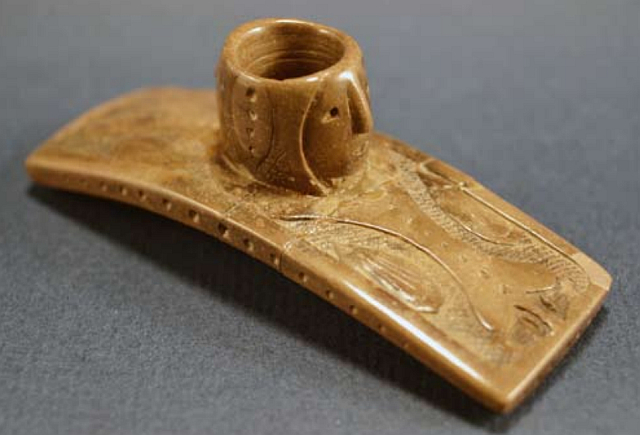|
This is an excerpt from "Prehistoric
Small Art at It’s Finest ".
Read the complete column in the Central
States Archaeological Societies 2022
July Journal which can be purchased on-line after March
2023
|
 |
| |
Webster defines art as: “(1) skill that comes through experience
or study; (2) an activity that requires skill; (3) an activity (as
painting, music, or writing) whose purpose is making things that are
beautiful to look at, listen to or read; and (4) works (as pictures,
poems, or songs) made by artists.” There is a saying that beauty
or art is in the eye of the beholder. Hence, art can be considered
as a matter of personal opinion. Personally, I enjoy paintings, sculptures
and certain types of music, and consider some of the finest modern
artworks to be Grant Wood’s American Gothic (1930), John James
Audubon’s Wild Turkey, Winslow Homer’s Breezing Up “A
Fair Wind,” Frederic Remington’s “Coming Through
the Rye,” and C.M. Russell’s “Smoking Up.” Western
sculptures and the Beach Boys music are favorites also. Prehistoric
peoples also enjoyed their fine art.
The earliest prehistoric cave painting, that of a life sized picture
of a wild pig, can be traced back to Indonesia, dating earlier than
45,000 years ago. European cave paintings first appeared in southeastern
France and are thought to be approximately 30,000 years old. Paleolithic
peoples had their “sculptures in stone” too. One classic
example is the Venus of Willendorf, a female figurine found near
Willendorf, Austria in 1908. The statuette is 4 ?” tall and
is made of oolitic limestone tinted with red ochre pigment. The statue
has been dated to 25,000 BC and is believed to be that of a fertility
goddess.
Pieces of stone effigy artwork didn’t appear in North America
until late in the Archaic Period (3000 to 500 BC). In the Midwest,
the first artisans of effigy figures were most likely the Glacial
Kame and Red Ocher peoples as their long-necked birdstones are much
admired and highly collectable artforms today. The oldest effigy
in the writer’s collection is that of a prehistoric animal
pipe. The pipe has a face of a crocodile and the body of a rhinoceros.
It was found in Vanderburgh County, Indiana near the Ohio River and
was made of quartzite which was probably fashioned 4,000- 4,500 years
ago. We call it “the Prehistoric Monster Pipe.”As time
progressed, specimens of North American prehistoric artworks became
more refined. The Early Woodland people of the Adena Culture (500
BC to AD 300) (a.) changed their birdstone designs to that of the
bust type, (b.) formulated the Great Pipe effigy art form tradition,
and (c.) created engraved stone tablets with complex and artistic
designs. Perhaps the Adena culture’s most notable work of art
is that of the “Adena Man” pipe, found at the original
Adena Mound, Chillicothe, Ohio in 1901. The pipe dates to 100 BC
to AD 100 and portrays a male dwarf in full dress regalia. It is
7 7/8” high and was carved and fashioned from Ohio grayish-brown
pipestone.
Many people, including the author believe that the Middle Woodland
Period’s Hopewell Culture took art to the topmost levels in
terms of prehistoric metal and stonework. The Middle Woodland Period
existed from approximately 200 BC to AD 500 (depending on geography)
and ranged from central New York state westward to the Mississippi
River, and from Ontario south to the Gulf shores. The two Hopewell
epicenters were located in south-central Ohio (Ohio Hopewell) and
western Illinois (Havana Hopewell and Crab - Orchard Hopewell). While
the Hopewell were not an organized nation, their lifestyle, religious
and burial practices, and fabrications are widely distributed across
an area much larger than their habitation base. The Hopewell produced
some of the finest craftwork found in North America. Their trade
network was expansive as they found or obtained a wide variety of
materials such as mica, galena, copper, silver, shark teeth, steatite,
pipestone, flint, obsidian and marine shell. From these they fashioned
a variety of ......
Read the complete column in the Central States Archaeological Societies 2022
July Journal which can be purchased on-line after March 2023 |
|




